Ahmed Magbool
Hiding in Plain Sight: RIS-Aided Target Obfuscation in ISAC
Mar 07, 2025Abstract:Integrated sensing and communication (ISAC) has been identified as a promising technology for the sixth generation (6G) of communication networks. Target privacy in ISAC is essential to ensure that only legitimate sensors can detect the target while keeping it hidden from malicious ones. In this paper, we consider a downlink reconfigurable intelligent surface (RIS)-assisted ISAC system capable of protecting a sensing region against an adversarial detector. The RIS consists of both reflecting and sensing elements, adaptively changing the element assignment based on system needs. To achieve this, we minimize the maximum sensing signal-to-interference-plus-noise-ratio (SINR) at the adversarial detector within sample points in the sensing region, by optimizing the transmit beamformer at the base station, the RIS phase shift matrix, the received beamformer at the RIS, and the division between reflecting and absorptive elements at the RIS, where the latter function as sensing elements. At the same time, the system is designed to maintain a minimum sensing SINR at each monitored location, as well as minimum communication SINR for each user. To solve this challenging optimization problem, we develop an alternating optimization approach combined with a successive convex approximation based method tailored for each subproblem. Our results show that the proposed approach achieves a 25 dB reduction in the maximum sensing SINR at the adversarial detector compared to scenarios without sensing area protection. Also, the optimal RIS element assignment can further improve sensing protection by 3 dB over RISs with fixed element configuration.
Optimal Beamforming Design for ISAC with Sensor-Aided Active RIS
Oct 16, 2024Abstract:Active reconfigurable intelligent surfaces (RISs) can improve the performance of integrated sensing and communication (ISAC), and therefore enable simultaneous data transmission and target sensing. However, when the line-of-sight (LoS) link between the base station and the sensing target is blocked, the sensing signals suffer from severe path loss, resulting in an inferior sensing performance. To address this issue, this paper employs a sensor-aided active RIS to enhance ISAC system performance. The goal is to maximize the signal-to-noise ratio of the echo signal from the target at the sensor-array while meeting constraints on communication signal quality, power budgets, and RIS amplification limits. The optimization problem is challenging due to its non-convex nature and the coupling between the optimization variables. We propose a closed-form solution for receive beamforming, and a successive convex approximation based iterative method for transmit and reflection beamforming design. Simulation results demonstrate the advantage of the proposed sensor-aided active RIS-assisted system model over its non-sensor-aided counterpart.
Multi-Functional RIS for a Multi-Functional System: Integrating Sensing, Communication, and Wireless Power Transfer
Oct 11, 2024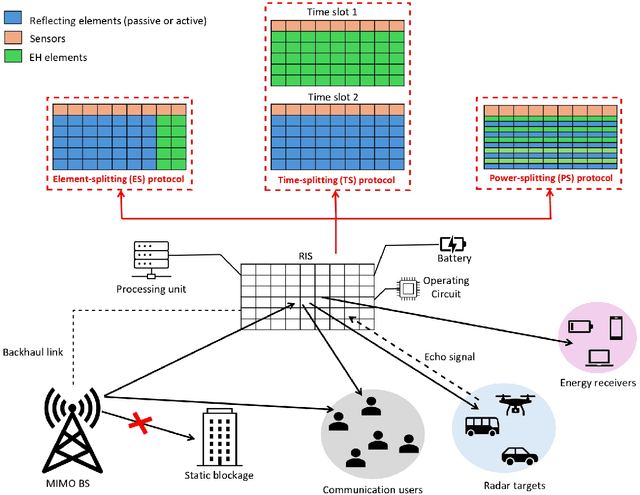
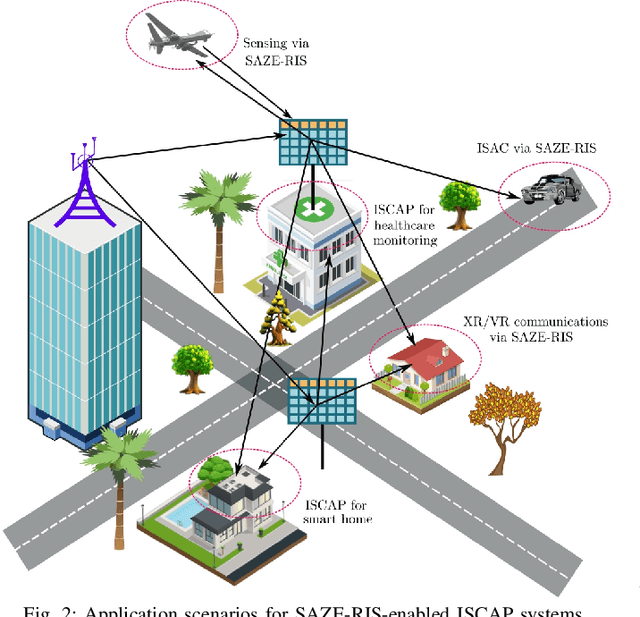
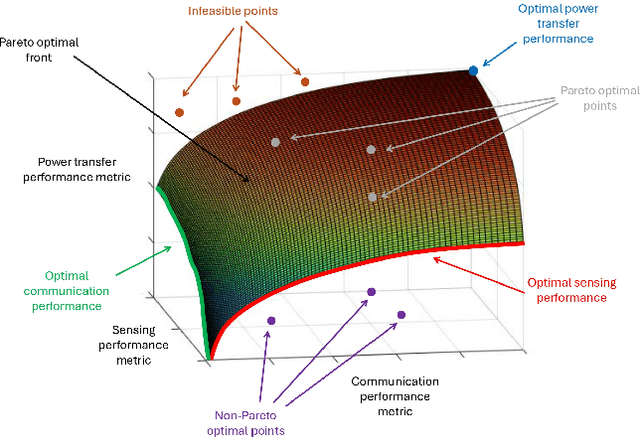
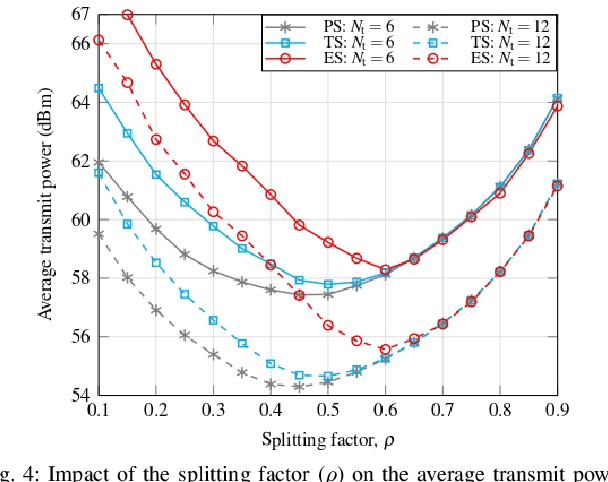
Abstract:Communication networks are evolving from solely emphasizing communication to facilitating multiple functionalities. In this regard, integrated sensing, communication, and powering (ISCAP) provides an efficient way of enabling data transmission, radar sensing, and wireless power transfer simultaneously. Such a multi-functional network requires a multi-functional architectural solution. Toward this end, sensor-aided zero-energy reconfigurable intelligent surfaces (SAZE-RISs) offer an energy-efficient solution for ISCAP by meeting the requirements of the end users as well as supplying power for the RIS. This paper explores the use of SAZE-RIS within the ISCAP framework. First, we present the general system architecture, operational protocols, and main application scenarios for employing SAZE-RIS in ISCAP. Next, we discuss methods for managing the conflicting requirements of communication, sensing, and powering within ISCAP and the role of SAZE-RIS in this process. We then provide a detailed case study complete with simulation results, offering valuable insights into the design choices and tradeoffs that come into play when adopting this technology. Furthermore, we discuss the related challenges and open research avenues, highlighting areas that require further exploration to fully realize the potential of SAZE-RIS within this ISCAP framework.
A Survey on Integrated Sensing and Communication with Intelligent Metasurfaces: Trends, Challenges, and Opportunities
Jan 28, 2024Abstract:The emergence of various technologies demanding both high data rates and precise sensing performance, such as autonomous vehicles and internet of things devices, has propelled an increasing popularity of integrated sensing and communication (ISAC) in recent years. ISAC offers an efficient framework for communication and sensing where both functionalities are carried out in a shared spectrum, utilizing the same hardware, beamformer and waveform design. At the same time, intelligent metasurfaces have been identified as an architectural enabler for the upcoming sixth-generation (6G) of wireless communication due to their ability to control the propagation environment in an energy-efficient manner. Due to the potential of metasurfaces to enhance both communication and sensing performance, numerous papers have explored the performance gains of using metasurfaces to improve ISAC. This survey reviews the existing literature on metasurface-assisted ISAC, detailing the associated challenges and opportunities. To provide a comprehensive overview, we commence by offering relevant background information on standalone metasurface-assisted communication and metasurface-assisted sensing systems, followed by a discussion on the fundamentals of ISAC. The core part of the paper then summarizes the state-of-the-art studies on metasurface-assisted ISAC with metasurfaces employed as separate entities placed between the transmitter and receiver, also known as reconfigurable intelligent surfaces, with an emphasis on its two levels of integration: radio-communications co-existence and dual-function radar-communications. We also review the current works in the area of holographic ISAC where metasurfaces are used to form part of ISAC transmitter. Within each category, the challenges, opportunities and future research directions are also highlighted.
Robust Beamforming Design for Energy Efficiency and Fairness Maximization in RIS-Assisted mmWave Communications
Jul 03, 2023Abstract:The use of reconfigurable intelligent surfaces (RISs) has been proposed in the past few years to achieve a better communication system performance by creating a programmable wireless propagation environment. In this paper, we target maximizing both energy efficiency and user fairness in RIS-assisted millimeter-wave systems with imperfect channel state information. We formulate the energy efficiency and fairness maximization problem as a multi-objective optimization problem. We split the corresponding multi-objective optimization problem into two stages using a lexicographic approach. In the first stage, the energy efficiency is maximized; then in the second stage, the fairness is maximized subject to a maximum reduction in the optimal value of the energy efficiency. We propose a projected gradient ascent based alternating optimization procedure to solve the optimization problem in each stage. We further employ the penalty dual decomposition method to address the challenging energy efficiency constraint in the second stage. Simulation results show that the proposed algorithm can achieve a better trade-off between energy efficiency and fairness compared to the methods that target only one of those metrics.
On Energy Efficiency and Fairness Maximization in RIS-Assisted MU-MISO mmWave Communications
Nov 16, 2022



Abstract:Reconfigurable intelligent surfaces (RISs) are considered to be a promising solution to overcome the blockage issue in the millimeter-wave (mmWave) band. Energy efficiency is an important performance metric in mmWave systems with a large number of antennas. However, due to the severe path loss in mmWave systems, resource allocation algorithms tend to allocate most of the resources for the benefit of the users with higher channel gains. In this paper, we propose a lexicographic-based approach to find the optimal power allocation, RIS phase shift matrix, and analog precoders that maximize both energy efficiency and user fairness. We solve the corresponding multi-objective optimization problem in two stages. In the first stage, we maximize the energy efficiency, and in the second stage we maximize the fairness subject to a minimum energy efficiency constraint. We propose an alternating optimization procedure to solve the optimization problem in each stage. The optimal power allocation is found using Dinkelbach's method in the first stage and using convex optimization techniques in the second stage, the RIS phase shift matrix is found using a gradient ascent algorithm, and the analog precoder is determined using beam alignment. Numerical results show that the proposed algorithm can achieve an excellent trade-off between the energy efficiency and fairness by boosting the minimum weighted rate with a minor and controllable reduction in the energy efficiency.
Terahertz-Band Non-Orthogonal Multiple Access: System- and Link-Level Considerations
Nov 02, 2021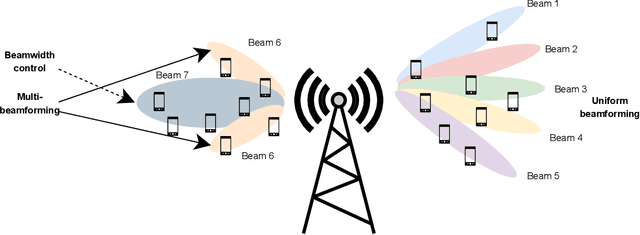
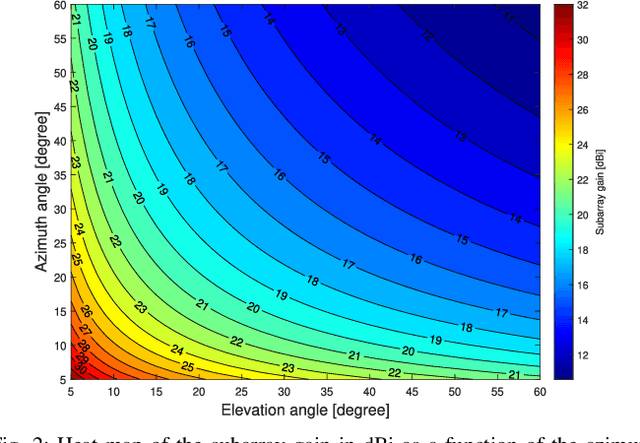
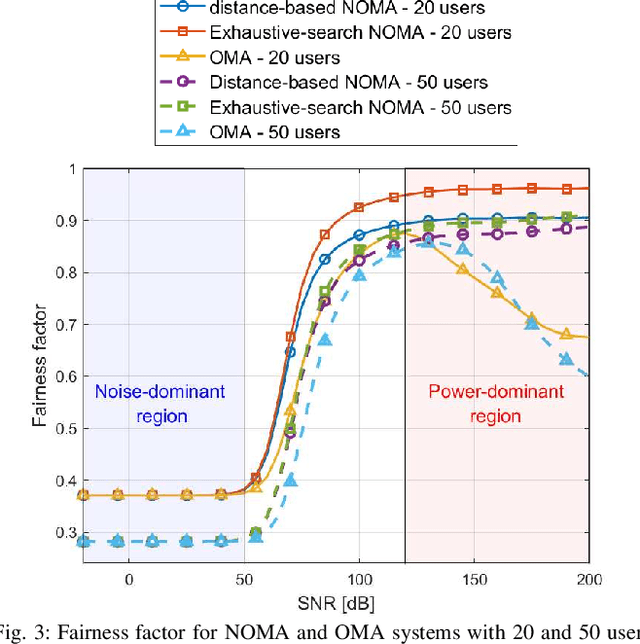
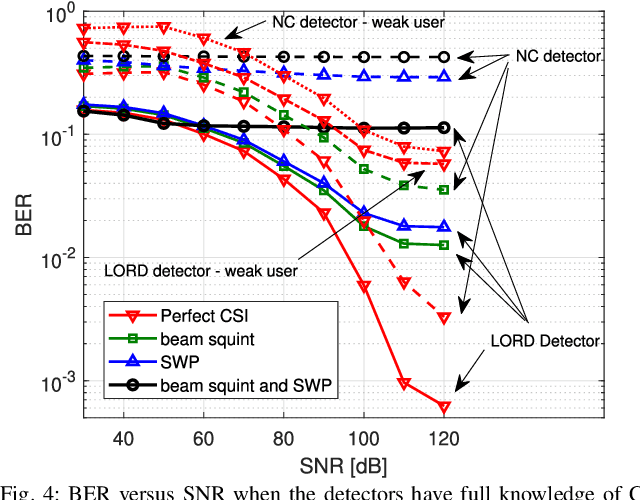
Abstract:Non-orthogonal multiple access (NOMA) communications promise high spectral efficiency and massive connectivity, serving multiple users over the same time-frequency-code resources. Higher data rates and massive connectivity are also achieved by leveraging wider bandwidths at higher frequencies, especially in the terahertz (THz) band. This work investigates the prospects and challenges of combining these algorithmic and spectrum enablers in THz-band NOMA communications. We consider power-domain NOMA coupled with successive interference cancellation at the receiver, focusing on multiple-input multiple-output (MIMO) systems as antenna arrays are crucial for THz communications. On the system level, we study the scalability of THz-NOMA beamforming, clustering, and spectrum/power allocation algorithms and motivate stochastic geometry techniques for performance analysis and system modeling. On the link level, we highlight the challenges in channel estimation and data detection and the constraints on computational complexity. We further illustrate future research directions. When properly configured and given sufficient densification, THz-band NOMA communications can significantly improve the performance and capacity of future wireless networks.
 Add to Chrome
Add to Chrome Add to Firefox
Add to Firefox Add to Edge
Add to Edge